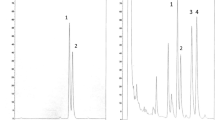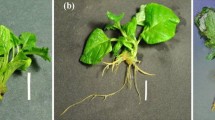Abstract
Plantlets regenerated from shoot-tip culture of Asparagus officinalis L. possessed weak shoots and roots. Various combinations of auxins and cytokinins did not improve the plantlets. Incorporation of a number of growth retardants, viz. ancymidol, B-995, phosfon, Amo 1618, cycocel and paclobutrazol, promoted growth of stronger shoots and roots. The effectiveness of the growth retardants varied, with ancymidol being most effective and cycocel least effective.
The response to ancymidol was prevented by exogenous GA3 and GA4/7. GA1/3 and GA4/7-like activities were detected in asparagus shoot-tip culture and these activities were reduced by the presence of the growth retardants ancymidol, Amo-1618, and cycocel.
Similar content being viewed by others
References
Murashige T, Shabde MN, Hasegawa PM, Taketori FB, Jones JB (1972) Propagation of asparagus through shoot apex culture. I. Nutrient medium for formation of plantlets. J Am Soc Hort Sci 97(2): 1258–161
Chin CK (1982) Promotion of shoot and root formation in asparagus in vitro by ancymidol. Hort Science 17: 590–591
Yang HJ, Clore WJ (1974) Improving the survival of aseptically-cultured asparagus plants in transplanting. Hort Science 9: 235–236
Murashige T, Skoog F (1962) A revised medium for rapid growth and bioassays with tobacco tissue cultures. Physiol Plant 15: 473–497
Powell IE, Tautvydas KJ (1967) Chromatography of gibberellins on silica gel partition columns. Nature 213: 292–293
Frankland B, Wareing PF (1960) Effect of gibberelic acid on hypocotyl growth of lettuce seedlings. Nature 4708: 255–256
Dennis DT, Upper CD, West CA (1965) An enzymatic site of inhibition of gibberellin biosynthesis by Amo-1618 and other plant growth retardants. Plant Physiol 40: 948–952
Nickell LG (1958) Gibberellin and the growth of plant tissue culture. Nature 181: 499–500
Murashige T (1964) Analysis of the inhibition of organ formation in tobacco tissue culture by gibberellin. Physiol Plant 17: 636–643
Russell GF, West CA (1977) Properties of Kaurene synthetase from Marah macrocarpus. Plant Physiol 59: 22–29
Coolbaugh RC, Hamilton R (1976) Inhibition of ent-kaurene oxidtion and growth by α-cyclopropyl-α-(p-methoxyphenyl)-5-pyrimidine methylalcohol. Plant Physiol 57: 245–248
Coolbaugh RC, Hirano SS, West CA (1978) Studies on the specificity and site of action of α-cyclopropyl-α-(p-methoxyphenyl)-5-pyrimidine methylalcohol (ancymidol), a plant growth regulator. Plant Physiol 62: 571–576
Leopold AC (1971) Antagonism of some gibberellin action by a substituted pyrimidine. Plant Physiol 48: 537–540.
Author information
Authors and Affiliations
Rights and permissions
About this article
Cite this article
Khunachak, A., Chin, CK., Le, T. et al. Promotion of asparagus shoot and root growth by growth retardants. Plant Cell Tiss Organ Cult 11, 97–110 (1987). https://doi.org/10.1007/BF00041843
Received:
Revised:
Accepted:
Issue Date:
DOI: https://doi.org/10.1007/BF00041843




